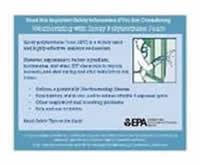Quick Safety Tips for Spray Polyurethane Foam Users
Spray polyurethane foam (SPF) is an effective insulation and air sealant material; however, exposures to its key ingredient, isocyanates, and other SPF chemicals that may be found in vapors, aerosols, dust, or on surfaces during and for a period of time after installation can cause adverse health effects such as:
- Asthma, a potentially life-threatening disease
- Sensitization, which can lead to asthma attacks if exposed again
- Lung damage
- Other respiratory and breathing problems
- Skin and eye irritation
Whether you are an applicator, helper, or building occupant where this product is applied, follow these steps to control exposures:
- Review label and product information for ingredients, hazards, directions, safe work practices, and precautions
- Ensure health and safety training is completed and safe work practices are followed to prevent eye, skin, and inhalation exposures during and after SPF installation
- Exercise caution when determining safe re-occupancy for unprotected occupants and workers based on the manufacturer’s recommendation.
If you experience breathing problems or other health concerns from weatherizing with SPF, seek immediate medical attention.
Only applicators and helpers using effective workplace practices (including ventilation), appropriate personal protective equipment, and other steps to control exposures should be present during and for a period of time after SPF installation. To avoid chemical exposures as these products cure, the occupants of the home/building, as well as workers from other trades, should not enter the site until the spray foam manufacturer's "re-occupancy" procedures have been satisfied.
Use the appropriate protection and best suited for each type of SPF product.
Since re-entry time is dependent on product formulation and other factors that affect curing, more general research as well as product specific studies are needed to understand when it is safe for unprotected workers or building/home occupants to re-enter.
Some manufacturers recommend 24 hours after application for the two-component high pressure "professional" SPF system for worker re-entry without the use of PPE and for re-occupancy by residents and other building occupants, but the recommended time may vary. Contact your manufacturer or supplier for specific guidance on ventilation time, re-entry time, and re-occupancy time for your specific product and scenario. Some manufacturers estimate that it can take approximately 8 to 24 hours to cure for one component foam, typically available in 12 oz. to 24 oz. cans. More research is needed to account for the potential variability of curing rates.
Get more information on ongoing research on re-occupancy times, product emissions, and ventilation rates through ASTM International Subcommittee D 22.05 on Indoor Air Quality. Exit
Spray foam that is correctly applied and allowed to fully cure is typically considered relatively inert (chemically inactive). However, certain factors impact curing rates, which may lead to unreacted chemicals potentially off-gassing over time. In addition, SPF chemicals may migrate and contaminate other surfaces in a building. Also, improper curing may impact the quality and performance of the foam.
The factors that impact curing rates include:
- Ambient conditions such as temperature and humidity
- Improper workplace practices (such as failing to shut down the HVAC system and the sealing of air vents)
- Poor applicator technique (improper mixing, proportioning, thickness of foam applied)
In addition, more research is needed regarding the long-term stability of the foam.

